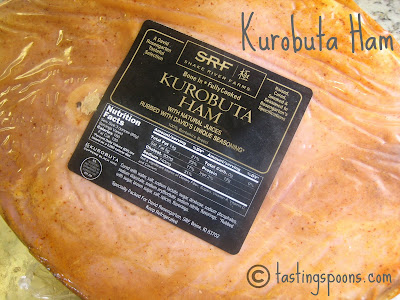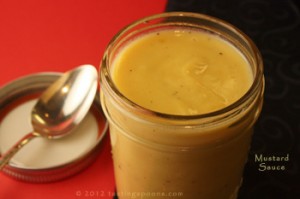
When I first started watching the TV Food Network, in its infancy, I really enjoyed David Rosegarten. He had a half-hour show every day around noontime, and regularly I tuned in while I had my salad or half a sandwich. He no longer has his own gig, although I guess he’s still a guest on some of the other Food Network shows. He’s moved on to bigger and better things, I suppose. He had a monthly food (mailed) news magazine, but now it’s an e-zine (The Rosegarten Report – available for a fee online). But you can subscribe (free) to his e-newsletter called Tastings, which arrives in your inbox every week. He scours the hills and dales of the world for the best food things, whether it’s caviar, olive oil, or in this case, ham. His endeavors tend toward the very high end, and I’ve reluctantly deleted most of the e-newsletters because of the costs.
But the story behind this ham was different. It hit a strong note with me. I’ve been, just like David Rosengarten, very unhappy with the state of the ham industry in the last 20+ years. Once the processors began injecting hams with water, I knew we, as consumers, were on a downhill spiral toward something that really isn’t ham anymore. I kept looking, but everywhere it was injected with water (with salt, surely, or sometime sugar too). Hams tended to be excessively salty – to me, at least. And yes, I’ve bought Honey Baked Ham multiple times. It’s okay if you like a really sweet ham. Somehow I think the sweet – the sugar and spices – just masks whatever taste there is underneath. And with my DH being a Type 1 diabetic (60+ years and counting), pouring sweet sauces or glazes on a ham make it very undesirable for him.
So, when I got David Rosengarten’s epistle recently, about ham, my ears (so to speak) perked up. I read avidly through the article about ham. Got to the bottom line and found that one ham, a half ham at that, was $100.00 plus shipping. Once again, I was ready to delete the message. $100 for a half ham? You’ve got to be kidding? But somehow my fingers just couldn’t press the delete button. I decided to think about it.
David Rosengarten was disappointed in the ham industry too. He kept seeking out hams everywhere he could find them. He read up about the pig farmers around our nation. He called and spoke to some of them. He bought hams everywhere from small farmers, hoping to find that elusive taste he remembers from his childhood. Nothing. But he kept working at it, and finally decided 3 years ago to go into business with a pig/hog farmer in Idaho called Snake River Farms, willing to raise the animals with his specific standards. I don’t now remember all the details, but it’s back to the basics, grass feed, no additives whatsoever, no hormones, butchered differently, smoked differently, but fresh, always fresh. Here’s what David Rosengarten’s e-zine had to say about this Kurobuta pig:
- About Kurobuta Ham: The breed actually arose in England, where it’s called “Berkshire” pork. But the English, in the 19th century, sent off a shipment of Berkshire hogs as a gift to Japanese diplomats—and the Japanese really flipped out. They gave the breed the name “Kurobuta,” meaning “black pig” (its coat is basically black), and developed an international reputation for Kurobuta pork, much as they did for Kobe beef. And Why Are These Porkers Superior? As you might expect, Kurobuta pigs yield meat that is indeed fattier than American supermarket pork. But—here’s the really cool thing—Kurobuta, though richly endowed with intramuscular fat, is not among the fattiest of breeds, which means that you never get a fatty, greasy taste when eating the pork. Instead, the real distinction of Kurobuta pork is a shorter, rounder muscle fiber—which, incredibly, leads to a much higher retention of moisture in the meat.
A week or so went by and I conferred with my DH about splurging on a special ham. He liked the story I conveyed about David Rosengarten’s Kurobuta hams too. So, I did splurge and buy one of these babies. It arrived on Thursday and into the refrigerator it went, where it sat until Easter Sunday.
 Included in the box was a brochure with some of David Rosengarten’s favorite holiday recipes (to serve with a ham), and details about how to prepare this ham, this very special ham. My daughter, Dana, made the mustard sauce on Saturday – a very easy preparation, although it does have to be cooked. It thickens some once it cools off, but it’s best served warm. There’s nothing unusual in it at all – dry mustard, sugar, vinegar, cream and egg yolks. It was just delicious. David Rosengarten’s recipe came from his grandmother-in-law, Mrs. Hitchcock, so I continued with the name. Need to give proper credit here, where it’s due. The sauce is succulent with the ham. Exceptional.
Included in the box was a brochure with some of David Rosengarten’s favorite holiday recipes (to serve with a ham), and details about how to prepare this ham, this very special ham. My daughter, Dana, made the mustard sauce on Saturday – a very easy preparation, although it does have to be cooked. It thickens some once it cools off, but it’s best served warm. There’s nothing unusual in it at all – dry mustard, sugar, vinegar, cream and egg yolks. It was just delicious. David Rosengarten’s recipe came from his grandmother-in-law, Mrs. Hitchcock, so I continued with the name. Need to give proper credit here, where it’s due. The sauce is succulent with the ham. Exceptional.
The ham, well, what can I say. It was absolutely wonderful. Worth $100? Yes, it was. Certainly more expensive than a whole chicken for Easter Dinner. We paid upwards of this amount for our kosher turkey just before Christmas, so spending $100 for the ham doesn’t seem quite so exorbitant. But yes, it was expensive. Too bad all the pig producers don’t learn a lesson from this, but their greed for more poundage and speed to market, means we’ll never have pigs like this unless someone like David Rosegarten produces them. Will I order it again? A resounding YES. The family is clamoring for leftovers.
printer-friendly PDF for mustard sauce
David Rosengarten’s Kurobuta Ham with Mustard Sauce
Cook’s Notes: This combo – ham and mustard sauce – is pretty straightforward. The ham is nothing but easy. It’s heated in a 275 degree oven for several hours. That’s one of the “secrets” to the pork – you don’t want to heat it in a hot oven. Slowly, you bring it up to 135 degree internal temp and that’s it. No added seasoning. No glaze. How much simpler could it be?
1 half or whole Kurobuta ham
Grandma Hitchcock’s Mustard Sauce
Recipe By: David Rosegarten’s grandmother-in-law
Serving Size: 12 [this is just a guess, no servings were shown on the recipe, although it makes 2 cups]
DRY INGREDIENTS:
1/4 cup dry mustard — Colman’s preferably
1/2 cup sugar
2 teaspoons kosher salt
1/2 teaspoon freshly ground black pepper
WET INGREDIENTS:
1/2 cup white vinegar
2 cups heavy cream
4 whole egg yolks — beaten (if using small eggs, use 5)
1. Combine the dry ingredients in a saucepan.
2. Whisk in the vinegar, cream and egg yolks (beaten), blending well to combine. Place over low heat, stirring constantly, until thickened and smooth. Serve warm.
Per Serving: 197 Calories; 17g Fat (74.9% calories from fat); 2g Protein; 10g Carbohydrate; trace Dietary Fiber; 125mg Cholesterol; 331mg Sodium.






Diana Campos
said on November 28th, 2013:
I told my sister about this ham and she purchased it for our early Thanksgiving dinner. She bought it at Jimmy p’s butcher shop. My mom who makes a traditional Farmer John’s bone in ham every year wasn’t pleased that my sister purchased an expensive ham without a bone. My mom grudgingly made it using her traditional marmalade glaze even though I told her it was not necessary. I made the mustard sauce. We had 19 people over for dinner. The ham was the favorite–better than my turkey. Everyone talked about how tender, delicious and not overly salty the ham tasted. Some of the guest asked for the mustard sauce recipe. My Mom was upset that there was so little leftover and stated we will have to splurge on this again soon. Thanks for sharing this recipe!
You are so welcome! Obviously I’m a big fan of Berkshire pork and have decided that it’s so worth it to splurge and buy it. I’m very judicious about giving away the leftovers – they make THE best ham sandwiches I’ve ever eaten. So happy you had a good story to tell and that everyone loved the mustard sauce. . . . carolyn t